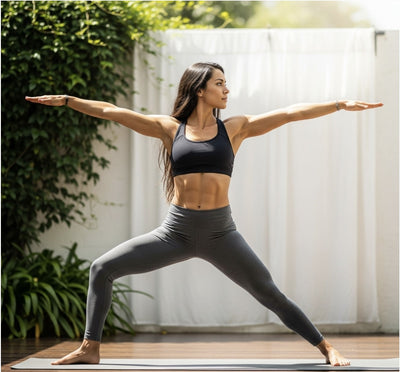
Tristhana: Breath, Posture, and Gaze in Ashtanga - 5To9Style
Share
Tristhana: Breath, Posture, and Gaze in Ashtanga
The Three Jewels of Ashtanga: Understanding Tristhana
Ashtanga Vinyasa Yoga, with its dynamic sequences and flowing movements, is a deeply holistic practice. At its core lies the principle of Tristhana, which translates from Sanskrit to "three places" or "three supports." These three vital elements – breath (Ujjayi Pranayama), posture (Asana), and gaze (Drishti) – work synergistically to create a powerful and transformative yoga experience. Understanding and integrating Tristhana is key to unlocking the deeper physical, mental, and spiritual benefits of Ashtanga.
Instead of viewing these elements in isolation, Ashtanga emphasizes their interconnectedness. Like three legs of a stable stool, each aspect supports and enhances the others, creating a balanced and focused practice that moves beyond mere physical exercise.
1. Breath (Ujjayi Pranayama): The Internal Rhythm
Ujjayi Pranayama, often referred to as "victorious breath" or "ocean breath," is the foundational breath of Ashtanga Yoga. It involves a slight constriction at the back of the throat during both inhalation and exhalation, producing a soft, audible hissing sound.

The Ujjayi breath serves several crucial functions within the Ashtanga practice:
- Internal Heat (Tapas): The constriction generates internal heat, which helps to warm the muscles, increase flexibility, and facilitate detoxification.
- Rhythmic Flow: The consistent sound and rhythm of the breath act as an internal metronome, dictating the pace and flow of the Vinyasas (linking movements) and the duration of the Asanas (postures).
- Mental Focus: By consciously listening to and controlling the breath, the mind becomes more focused and less prone to wandering. The breath becomes an anchor for attention, drawing awareness inward.
- Energy Regulation: Ujjayi breath helps to regulate the flow of prana (life force energy) throughout the body, promoting balance and vitality. Just as comfortable and breathable yoga wear supports physical movement, consistent Ujjayi breath supports internal energy flow.
2. Posture (Asana): The Physical Foundation
Asana in Ashtanga refers to the specific series of postures performed in a precise order. Each posture builds upon the previous one, developing strength, flexibility, balance, and stamina. The emphasis is on proper alignment and engagement of the body.

The Asanas in Ashtanga are not merely static stretches; they are dynamic expressions of physical and mental discipline. The key aspects of Asana within Tristhana include:
- Proper Alignment: Paying meticulous attention to the correct alignment of the body in each pose to ensure safety, maximize benefits, and facilitate the flow of energy.
- Muscular Engagement (Bandhas): Activating the internal energy locks (Mula Bandha and Uddiyana Bandha) to stabilize the core, support the spine, and direct prana.
- Progressive Series: Following the fixed sequences allows the body to gradually open and strengthen, preparing for more challenging postures over time. This systematic approach ensures a holistic development of physical capabilities. Choosing the right yoga mat provides a stable foundation for these postures, just as Asana provides the physical foundation for Tristhana.
3. Gaze (Drishti): The Point of Concentration
Drishti refers to the specific focal point for the eyes during each Asana. There are nine primary Drishti points in the Ashtanga system (e.g., the tip of the nose, between the eyebrows, the navel, the thumbs, the toes).
The purpose of Drishti is multifaceted:
- Enhancing Focus: Fixing the gaze helps to quiet the mind by reducing external distractions and promoting single-pointed concentration.
- Deepening the Pose: Directing the gaze in a specific way can sometimes influence balance and deepen the stretch in a particular area of the body.
- Internalization of Awareness: By drawing the gaze inward, Drishti encourages a shift of attention from the external world to the internal sensations and experience of the pose.
- Developing Mental Discipline: Maintaining Drishti throughout the practice cultivates mental discipline and the ability to stay present even when faced with physical challenges.
The Interconnectedness of Tristhana
The true power of Ashtanga Yoga lies in the integration of these three elements. Breath dictates the movement, posture provides the physical foundation, and gaze focuses the mind. When practiced together, Tristhana creates a powerful synergy:
- Breath and Movement Synchronization: The Ujjayi breath initiates and sustains each movement, creating a continuous flow (Vinyasa).
- Posture and Gaze Alignment: Drishti often supports the alignment of the body within the Asana, deepening the pose and enhancing stability.
- Mind-Body Integration: The focused breath and gaze keep the mind present in the body throughout the physical practice, fostering a deep connection between the two. This integrated practice can be supported by comfortable and functional yoga gear.
By diligently practicing and integrating Tristhana, Ashtanga practitioners cultivate not only physical strength and flexibility but also mental clarity, emotional balance, and a deeper connection to their inner selves. It is this powerful trinity that makes Ashtanga a transformative and deeply spiritual practice.
Integrating the Three Supports into Your Practice
Ready to deepen your Ashtanga journey by fully embracing Tristhana? Consciously focus on your Ujjayi breath, precise Asana alignment, and steady Drishti in each pose. For high-quality yoga mats, supportive yoga blocks, and comfortable yoga wear to enhance your practice, explore our collection at https://5to9style.com/collections/all.
Unlock the full potential of Ashtanga Yoga by mastering the three pillars of Tristhana. Visit our homepage for more insights and to find products that support your mindful movement: https://5to9style.com.









